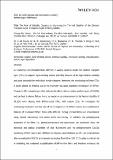The role of metallic dopants in improving the thermal stability of the electron transport layer in organic light-emitting diodes
Abstract
4,7‐Diphenyl‐1,10‐phenanthroline (BPhen) is widely used to create the electron transport layer (ETL) in organic light‐emitting diodes (OLEDs) because of its high electron mobility and good compatibility with alkali metal n‐dopants. However, the morphology of these ETLs is easily altered by heating due to the relatively low glass transition temperature (Tg) of BPhen and this change often reduces the performance of OLEDs. Here, an enhancement in the thermal stability of OLEDs when doping their BPhen‐based ETLs with cesium (Cs) is reported. To investigate the role of the Cs dopant in the BPhen matrix, the crystallization features of Cs‐doped BPhen films with different doping concentrations are examined. Next, the electrical and optical properties of blue fluorescent and red phosphorescent OLEDs containing Cs‐doped BPhen ETLs are characterized after annealing the OLEDs at temperatures up to 100 °C. Cs plays a critical role in inhibiting the undesired crystallization of BPhen films, which enhances the thermal stability of OLEDs beyond the Tg of neat BPhen. Finally, highly stable BPhen‐based OLEDs encapsulated via atomic layer deposition at 80 °C are demonstrated. This work may lead to a new strategy for enhancing the intrinsic thermal durability of organic devices and their compatibility with thermally demanding processes.
Citation
Keum , C-M , Kronenberg , N M , Murawski , C , Yoshida , K , Deng , Y , Berz , C , Li , W , Wei , M , Samuel , I D W & Gather , M C 2018 , ' The role of metallic dopants in improving the thermal stability of the electron transport layer in organic light-emitting diodes ' , Advanced Optical Materials , vol. Early View , 1800496 . https://doi.org/10.1002/adom.201800496
Publication
Advanced Optical Materials
Status
Peer reviewed
ISSN
2195-1071Type
Journal article
Description
This research was financially supported by the EPSRC NSF - CBET lead agency agreement (EP/R010595/1, 1706207), the DARPA-NESD program (N66001-17-C-4012) and by the EPSRC CDT Capital Equipment funding stream (EP/L017008/1). C.- M.K. acknowledges support from Basic Science Research Program through the National Research Foundation of Korea (NRF) funded by the Ministry of Education (2017R1A6A3A03012331). C.M. acknowledges funding by the European Commission through a Marie Skłodowska Curie Individual Fellowship (703387). Y.D., W.L., and M.W. acknowledge stipends from the Chinese Scholarship Council (CSC). I.D.W.S. acknowledges support from a Royal Society Wolfson research merit award.Collections
Items in the St Andrews Research Repository are protected by copyright, with all rights reserved, unless otherwise indicated.

